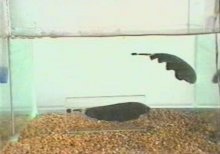Stichting De Traditie -
Cultural
Heritage



Utrecht - Science
Comparative Physiology - Electroreception video clips

A single specimen of the black ghost knifefish Apteronotus albifrons (Linnaeus, 1766), emanates wave-shaped (about 800 Hz) electric fields with its electric organ. The electric discharges were recorded with the aid of two stainless steel electrodes, at the left side of the tank, and made audible by a speaker. Apteronotus swims backwards as easily as forwards. The electrical sense is used for detecting objects and obstacles. Their ability to detect very weak electrical fields in the turbid streamlets in which they live is essential for survival. Two specimens of black ghost knifefish (Linnaeus, 1766), give off electric fields that interfere with each other. In order to avoid such interference, the fish shift their discharge frequencies in opposite directions. This behavior is called "Jamming Avoidance Response" (JAR). The fish react also to each other's presence with "chirps", sudden changes in the otherwise stable discharges (recording Dr. Tim van Wessel).

A single specimen of the elephantnose fish Gnathonemus petersii (Guenther, 1862) lies in a perspex tube and 'explores' its environment with electrical pulses (EODs) produced by the Electric Organ. The organ that generates electrical pulses lies in the tail. The pulses are a few volts strong. The pulses were recorded using two stainless steel electrodes at the left side of the tank, and made audible through a speaker. If an iron ball is dipped into the aquarium, Gnathonemus becomes alarmed, and raises the frequency of its exploring pulses. Deformations of the pulse field by objects having a conductivity different from water, are in this way detected. Two specimens: If a second specimen is released into the tank, an extensive exchange of electrical signals starts with the aim to establish their dominance hierarchy. Fish can recognize their electrical signals, and communicate with them (recording Dr. Tim van Wessel).



Image left, top: A catfish, Ameiurus (Ictalurus) nebulosus (Lesueur, 1819), catches a tadpole (Xenopus) in murky water. The catfish is hungry, and excited after having smelled aquarium water with tadpole-flavour. The tadpole swims from left to right at the surface, but it is hard to see. The murky water comes from the lake where the catfish was caught.
Image left, bottom left: The same specimen swims along a plastic imitation of a tadpole without apparently paying attention to it. Although the catfish is hungry and excited due to the water-that-smells-of-tadpoles, it does not show an intention to catch the dummy tadpole.
Image left, bottom right: The same specimen captures an 'electrified' dummy tadpole, that emits an electric field similar to that of a living tadpole. The electric field was recorded from a living tadpole by means of two electrodes, and played back through two electrodes which are attached to the dummy-tadpole. The catfish reacts as if the dummy were alive.
The original recordings were made on Super-8 film by J.Meek in 1974. See also: Peters-RC, Meek-J 1973. Catfish and Electric Fields. Experientia (Basel) 29, 299-300.
20200118